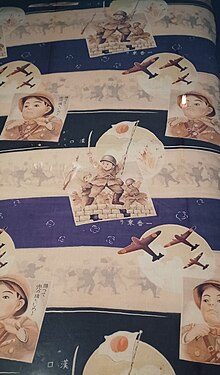Hankou
| Hankou 汉口市 | |||||||||||
|---|---|---|---|---|---|---|---|---|---|---|---|
| City of China | |||||||||||
| 1921–1954 | |||||||||||
 The map of Hankou (top left, with the five foreign concessions), Hanyang, and Wuchang, as of 1915 | |||||||||||
| Area | |||||||||||
| • Coordinates | CN-HB-01 30°34′52″N 114°16′21″E / 30.581179°N 114.272597°E | ||||||||||
| History | |||||||||||
• Established | 3 July 1921 | ||||||||||
• Disestablished | June 1954 | ||||||||||
| |||||||||||
| Today part of | A part of Qiaokou ) | ||||||||||
Hankou,
Hankou is the main port of Hubei Province and the single largest port in the middle reaches of Yangtze.[citation needed]
History

The city's name literally means "
Hankou, from the
In 1926, Hankou was officially established as a city, where its municipal government was built in
Revolutionary periods
Hankou was the destination on the escape route of groups of missionaries fleeing the
by Reverend A E Glover, one of the fleeing missionaries.

On 10 October 1911, a revolution to establish the
Foreign concessions period

Hankou used to have five foreign
In 1862, Russian tea merchants arrived in the British concession of Hankou. Russians in Hankou established four factories using assembly lines and machinery to produce brick tea, and became the city's richest industrialists in what would become the Russian concession.[8][9]

Early in 1927, the British concession was occupied in the course of the revolutionary troubles that accompanied the Northern Expedition when the Chinese Kuomintang forces occupied the concession and showed no intention of withdrawing. The Chen-O'Malley Agreement of February 1927 provided for a combined British-Chinese administration of the concession and in 1929 the British concession formally came to an end. From then on it was administered by the Chinese authorities as the Third Special Area.

In the 1920s and 30s, Hankou was one of the Yangtze River ports patrolled by the US Navy to maintain US interests in the area (Yangtze Patrol.)

Hankou was flooded in the 1931 China floods.

Hankou was captured by the Japanese invaders in 1938 (Battle of Wuhan).
An important logistical center, the city was heavily bombed in December 1944 by the US aircraft based in the Chengdu area (part of Operation Matterhorn).
On 19 August 1945, a group of enraged Chinese civilians and soldiers massacred 26 Japanese soldiers in the Hankou reprisal massacre.
The government of Vichy France relinquished the French concession in 1943, and the restored French Republic relinquished it formally in 1946.
The Japanese concession came to an end with the surrender of Japan in 1945.
Before the Communist Revolution, Hankou was the seat of the Roman Catholic Archdiocese of Hankou, covering the province of Hubei. The dioceses in Wuchang, Hanyang and elsewhere in the province were subordinated to it.
In the 1930s, the airports served in Hankow were Wuhan Wangjiadun Airport and Wuhan Nanhu. Wangjiadun served as a civil and military base until 2007 while Nanhu, on the other hand, shut down while Tianhe Airport opened in 1995.

Modern status

"Hankou" remains a commonly used name for the part of Wuhan urban area north of the Yangtze and Han Rivers. The name was long preserved in the name of the old Hankou Railway Station (also known as
Nonetheless, Hankou is no longer the name of an administrative unit (e.g., a
Media
Hankou once had an English-language newspaper, The Hankow Daily News, which was published by a German individual.[10]
Education
- David Hill memorial school (1883)
References
Citations
- ^ Zhongguo Gujin Diming Dacidian 中国古今地名大词典, 964.
- ^ a b "历史沿革". Archived from the original on June 25, 2012. Retrieved March 21, 2012.
- ^ a b "江汉综述". Archived from the original on February 2, 2014. Retrieved March 21, 2012.
- ^ Jacob, Mark (2012-05-13). "Chicago is all over the place". Chicago Tribune. Archived from the original on 2013-05-11. Retrieved 2012-05-22.
- ^ ""武汉"的由来". Archived from the original on April 25, 2012. Retrieved March 31, 2012.
- ^ "武汉近代建市及其历史意义". Archived from the original on February 2, 2014. Retrieved March 31, 2012.
- ^ Glover, Archibald E. (1919). A Thousand Miles of Miracle in China: A personal record of God's delivering power from the hands of the Imperial Boxers of Shan-si (Eleventh ed.). London: Pickering & Inglis.
- ^ "The British Concession and the First Years of the Treaty Port · Hankou to Wuhan: Histories from China's Crossroads · Hankou to Wuhan". hankoutowuhan.org. Retrieved 2023-04-03.
- JSTOR 43737542.
- ^ Walravens, p. 91.
Sources
- Walravens, Hartmut (January 1, 2003). "German Influence on the Press in China". Newspapers in International Librarianship: Papers Presented by the Newspaper Section at IFLA General Conferences. ISBN 3110962799. Archived from the originalon June 17, 2003.
- Also available in Walravens, Hartmut and Edmund King. Newspapers in international librarianship: papers presented by the newspapers section at IFLA General Conferences. ISBN 3598218370, 9783598218378.
- Also available in Walravens, Hartmut and Edmund King. Newspapers in international librarianship: papers presented by the newspapers section at IFLA General Conferences.
- "Japanese Invasion of China: Hangkou / Hanhkow (1937-38)". Historical Boys' Clothing. September 19, 2011.
- Rowe, William T. (1984). Hankow: Commerce and Society in a Chinese City, 1796-1889. Stanford University Press.
- Rowe, William T. (1992). Hankow: Conflict and Community in a Chinese City, 1796-1895. Stanford University Press.
